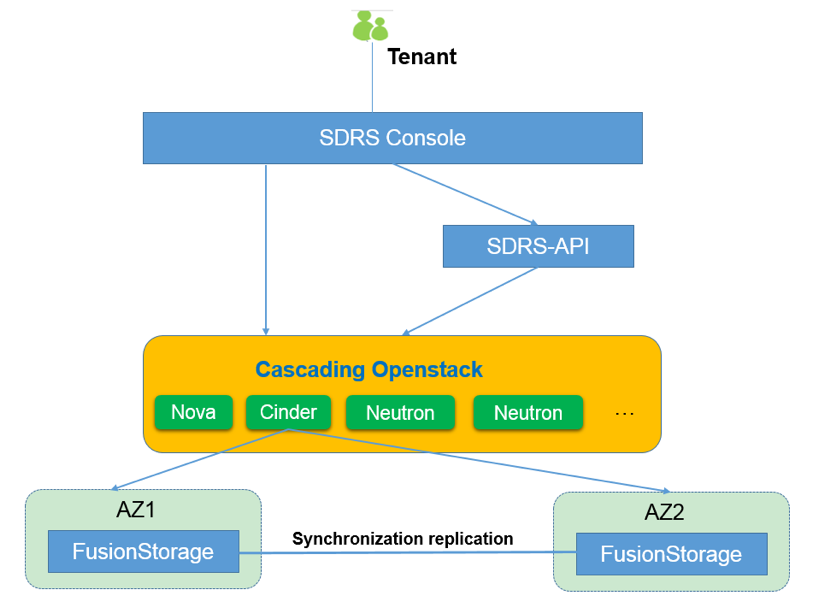Public Cloud – Flexible Engine
Storage Disaster Recovery Service (SDRS) – Simplify disaster recovery process
A turnkey disaster recovery solution on Flexible Engine

The Storage Disaster Recovery Service (SDRS) provides inter-AZ disaster recovery protection for Elastic Cloud Servers (ECS). It supports the recovery point goal (RPO) of 0, significantly reduces the total cost of operation (TCO) of disaster recovery for businesses, and simplifies the disaster recovery process. If an error occurs in the Preferred Availability Zone, users can quickly restore services to another Availability Zone. This drastically shortens service interruptions and reduces losses.
SDRS consists of the following components: SDRS Console, SDRS API, OpenStack Cinder, and FusionStorage.
The SDRS console provides entry to the SDRS for tenants. Tenants can perform a variety of console operations, including creating protection groups, creating protected instances, adding protected instances to a protection group, and performing failovers and failbacks. planned background.
SDRS APIs can be called by the SDRS console or tenants.
FusionStorage provides Elastic Volume Service (EVS) storage and replication functions for SDRS.

RDS characteristics
- Zero RPO and dynamic real-time synchronization ensure data consistency.
- A centralized console is provided to allow users to configure and manage replication as well as perform failovers and rollbacks.
- When users perform a failover or restore, applications running on the ECS will not be affected. Replication supports all applications running on Huawei Elastic Cloud (ECS) servers.
Basic concepts
Protection group :
Used to manage a group of ECS requiring replication. A protection group can manage ECS in a virtual private cloud (VPC). If a tenant has multiple VPCs, the tenant must create multiple protection groups.
- Source AZ :
Spécifie l’AZ de l’ECS et est configuré lorsque les tenants créent un groupe de protection.
- Target AZ :
Specifies the AZ of the ECS after replication and is configured when tenants create a protection group. In the current version, only a different AZ in the same region with the source AZ can be selected as the target AZ.
- Protected instance :
Indicates a pair of ECS with the replication relationship. A projected instance belongs to a specific protection group. Therefore, the AZs of this pair of ECS are the same as the source and target AZ of the protection group.
- Replication pair :
Indicates an EVS disk pair with the replication relationship. A replication pair belongs to a specific protection group and can be attached to a protected instance in the same protection group. Therefore, the AZs of this EVS disk pair are the same as the source and target AZ of the protection group.

Benefits
Disaster recovery for the business (Recovery Point Objective “RPO” = 0)
Ensures consistency of data failures, reduces data loss and improves service continuity.
Low cost
The service is paid per use. Users do not need to set up disaster recovery centers themselves, which reduces disaster recovery costs.
Flexible deployment
Users can configure protected instances based on service policies to meet the different requirements of disaster recovery scenarios.
Simple operations
Disaster recovery is provided on a self-service basis. Users can complete the disaster recovery setup with just a few clicks on the console, even if the users do not have professional disaster recovery skills.
Features
| Category | Features | Description |
| Protection group | Creating a protection group | Users can create a protection group on the page. During the creation, users need to configure the source and target AZs and source VPC. The protected instances need to be in the source VPC. |
| Deleting a protection group | Users can delete a protection group on the page. The protection group cannot contain any protected instances or replication pairs. | |
| Protected instance | Creating a protected instance | Users can click a protected instance on the protection group page to switch to the protection group details page. On this page, users can create a protected instance. Users are allowed to select only one source ECS each time. |
| Deleting a protected instance | Users can delete a protected instance only when the protected instance is in the available state. | |
| Attaching a replication pair | Users can attach a replication pair to a protected instance, which equals to attaching the two EVS disks in the replication pair to the two ECSs in the protected instance. | |
| Detaching a replication pair | Users can detach a replication pair from a protected instance, which equals to detaching the two EVS disks in the replication pair from the two ECSs in the protected instance. | |
| Modifying specifications | When the source ECS is in the stopped state, users can modify the specifications of the protected instance. Then, the ECSs at both the source and target AZs use the new specifications. | |
| Replication pair | Creating a replication pair | On the replication pair details page, users can create a replication pair. Only one EVS disk can be added each time. |
| Expanding capacity of a replication pair | If users expand the capacity of a replication pair, the capacity of the two EVS disks in the replication pair are expanded. | |
| Deleting a replication pair | Users can delete a replication pair only when the replication pair is in the available state. | |
| Basic function | Enabling protection | Users can enable protection for a protection group after adding a protected instance to the protection group or performing a failover. The protection is enabled to start data replication, and the replication progress will be displayed. This operation affects all protected instances in the protection group. |
| Performing a planned failover | This operation affects all protected instances in the protection group. Users need to stop ECSs at the source AZ before the failover, and start ECSs at the target AZ after the failover. After the failover, services at the source AZ are not allowed to start, and services at the target AZ are allowed to start, and users cannot add other protected instances or replication pairs to the replication group. To add protected instances or replications pairs, users need to perform a failback on the protection group. | |
| Performing a failover | This operation affects all protected instances in the protection group. After a failover, services at the source AZ are not allowed to start, and services at the target AZ are allowed to start, and users need to start ECSs at the target AZ. After a failover, the protection group enters the failover state, and the data synchronization is stopped. Users need to enable the protection to start the data synchronization. | |
| Performing a failback | Cette opération affecte toutes les instances protégées du groupe de protection. Les utilisateurs doivent arrêter les ECS au niveau de la zone de disponibilité cible avant la restauration automatique et démarrer les ECS à la zone de disponibilité source après la restauration. |
Use case
Replication is based on the cross-AZ synchronization capability of backend storage. It is suitable for common applications without disaster recovery capabilities.
| Parameter | Value |
| RPO | 0 |
| Maximum synchronization rate per Replication Pair | 1 GB/s |
| Minimum synchronization rate per Replication Pair | 1 MB/s |